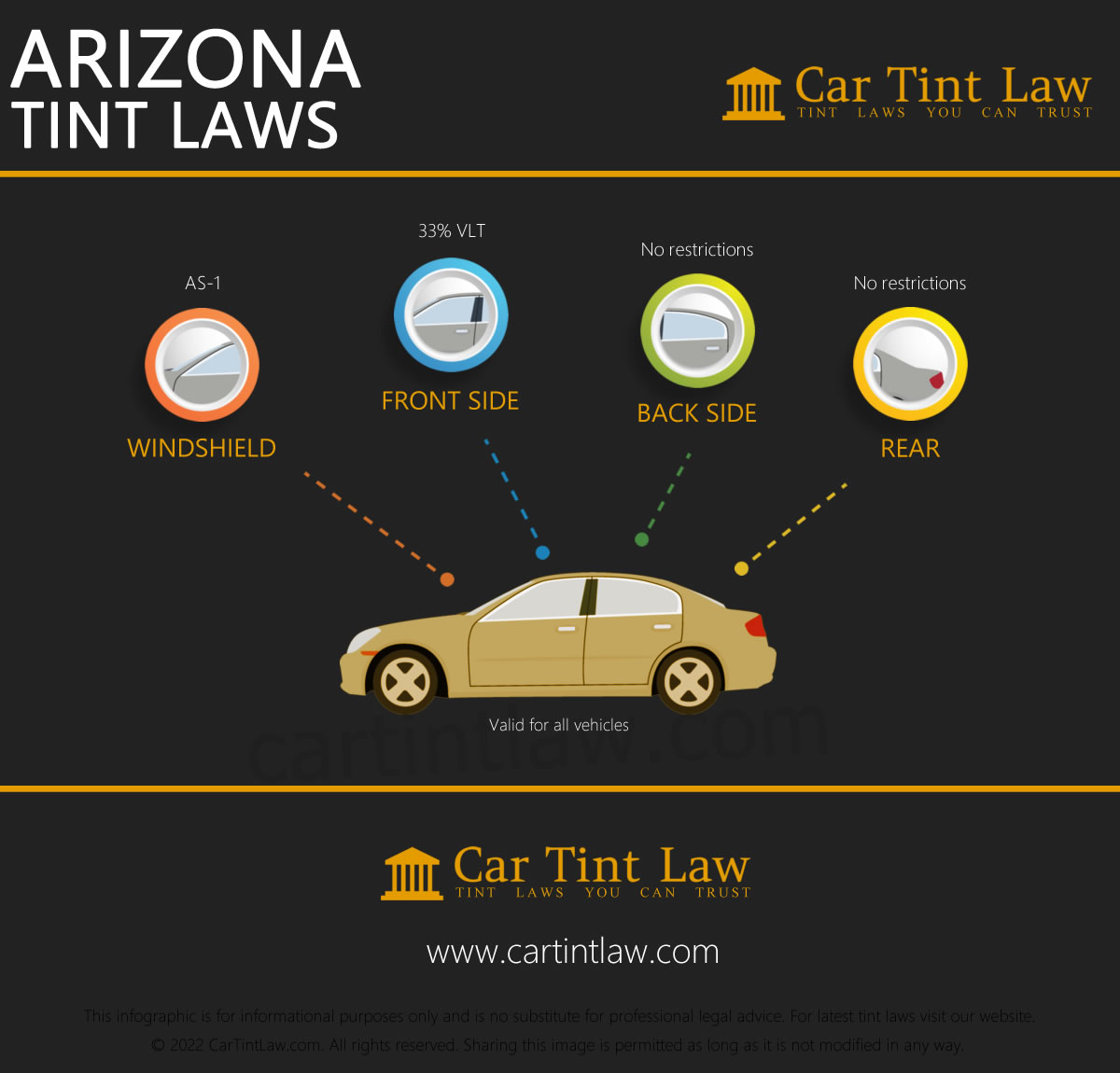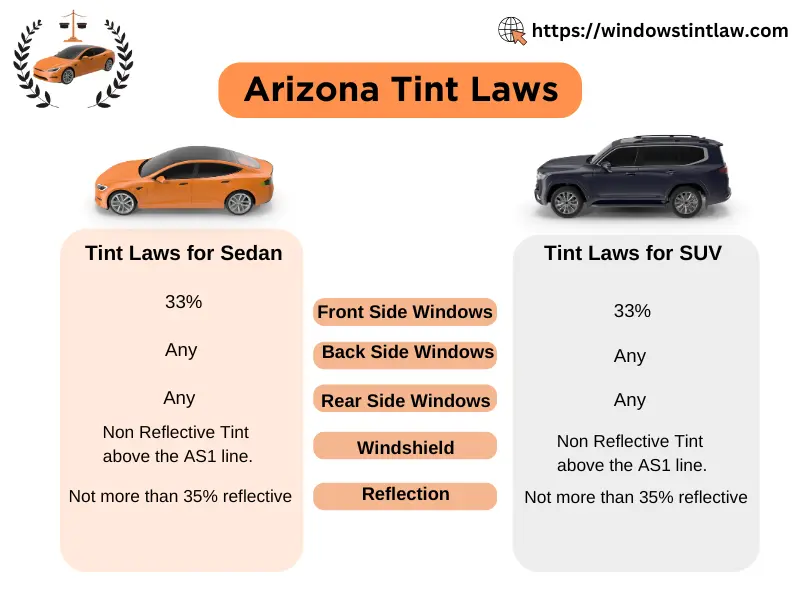Are you driving in Arizona and wondering if your window tinting is legal? You’re not alone.
With the sun blazing down, tinting your car windows might seem like a great idea to keep your ride cool and private. But before you make any changes, it’s crucial to understand Arizona’s tint laws. These regulations are designed to ensure safety and visibility on the road, and violating them could land you a hefty fine.
We’ll break down everything you need to know about Arizona’s tint law, so you can make informed decisions and stay on the right side of the law. Let’s dive in to find out how you can enjoy the benefits of window tinting without the legal headaches.

Credit: www.cartintlaw.com
Tint Law Basics
Arizona’s tint law covers rules for car window tinting. Knowing these rules helps ensure compliance. Drivers should be aware of tint percentages and restrictions.
Definition Of Window Tinting
Window tinting involves applying a thin film to car windows. This film changes how much light passes through. Tinting can reduce glare, improve privacy, and enhance vehicle appearance.
Different tint films offer varying levels of darkness. Each type provides different benefits. Some films block UV rays while others maintain cooler temperatures inside the car.
Purpose Of Tint Regulations
Arizona tint laws aim to ensure safety on the road. Proper visibility is crucial for drivers. Too dark a tint can impede vision, especially at night.
Regulations also aim to assist law enforcement officers. Clear visibility into vehicles can enhance safety during traffic stops. Tint laws balance driver privacy with public safety needs.

Credit: thetintlaws.com
Legal Limits
Understanding the legal limits of window tinting in Arizona can save you from unwanted fines and ensure you’re riding safely and stylishly. Whether you’re looking to keep your car cool or boost its aesthetic appeal, knowing the specific regulations is crucial. Are your windows tinted legally according to Arizona law?
Visible Light Transmission (vlt) Requirements
In Arizona, the amount of light that must pass through your window tint is specified by the Visible Light Transmission (VLT) percentage. This percentage determines how dark your tint can be.
For passenger vehicles, the front side windows must allow more than 33% of light in. This means your tint should be light enough for visibility and safety.
Meanwhile, rear windows have more flexibility, allowing you to use darker tints. Arizona law permits any darkness for the back side windows and rear window.
How does your current tint measure up? A simple test with a VLT meter might reveal insights you didn’t expect.
Front And Rear Window Regulations
The front windshield has its own rules. Arizona law permits a non-reflective tint on the top portion—above the AS-1 line or the top 5 inches.
For rear windows, as mentioned earlier, there’s freedom to go as dark as you desire. This allows for privacy and protection from harsh sunlight.
Before you tint your windows, check the manufacturer’s guidelines and ensure compliance with Arizona’s stipulations. Have you ever noticed how the right tint can transform a vehicle’s look?
Side Mirror Considerations
Side mirrors are often overlooked in tint regulations. In Arizona, if your rear window is tinted, your vehicle must have dual side mirrors for safety.
These mirrors compensate for reduced visibility caused by dark rear tints, ensuring drivers can see clearly on both sides.
Next time you consider tinting your windows, remember to check your side mirrors. Have you ever tried driving with tinted rear windows and found side mirrors essential?
Being informed about these legal limits not only keeps you compliant but also enhances your driving experience. Remember, a well-tinted vehicle is not just about style—it’s about adhering to safety and legal standards.
Exceptions And Exemptions
Arizona Tint Law outlines exceptions and exemptions for vehicle window tinting. Medical conditions may allow darker tints. Commercial and government vehicles often have different tint regulations, ensuring safety and compliance.
Navigating the world of automotive regulations can sometimes feel like a maze. The Arizona Tint Law is no exception, with its detailed rules on how much tint is permissible on your vehicle’s windows. But did you know there are exceptions and exemptions that can make your life a little easier? These special cases mean that not everyone is bound by the same tint restrictions. Understanding these can save you from potential fines or legal hassles, especially if you meet certain criteria or drive a unique type of vehicle.Medical Exemptions
In Arizona, there are provisions for those who have specific medical conditions that require greater protection from sunlight. If you have a medical condition like lupus or photosensitivity, you might qualify for a medical exemption. This allows you to use darker window tints than typically permitted. To apply for a medical exemption, you need a physician’s letter detailing your condition and the necessity for the tint. It’s crucial to ensure you have this documentation readily available in your vehicle. Imagine the relief when you’re pulled over and can confidently present your exemption letter, avoiding fines and legal issues. Are you aware of how this could change your driving experience?Special Vehicle Classifications
Certain vehicles have their own unique rules when it comes to window tinting. If you drive an SUV or a van, you might be surprised to learn that these vehicles often have more lenient tint regulations. This means you can enjoy a cooler, more comfortable ride without worrying about breaking the law. For instance, commercial vehicles used for transporting goods or passengers might have different tint standards. This is often due to the need for privacy or protection of the interior from harsh sunlight. It’s essential to know the classification of your vehicle and the specific rules that apply. Are you driving a vehicle that qualifies for different tint standards? Understanding these exemptions can make a significant difference in your comfort and compliance with the law.Penalties For Non-compliance
Arizona’s tint law aims to ensure drivers’ safety and clear visibility. Not following these rules can lead to serious penalties. These penalties affect your wallet and your vehicle’s compliance status. It’s crucial to understand these consequences to avoid unnecessary trouble.
Fines And Citations
Non-compliance with Arizona’s tint law may result in fines. These fines vary based on the severity of the violation. Most first-time offenders face a financial penalty. Repeat violations could lead to higher fines. Police officers issue citations for illegal window tinting. These citations serve as an official notice of your violation. Paying attention to tint regulations can help avoid these costs.
Impact On Vehicle Inspection
Vehicle inspections check for compliance with tint laws. Non-compliant vehicles may fail the inspection process. This failure can lead to additional costs and delays. Fixing tint violations is often required before passing inspection. Your vehicle’s registration may be impacted. Keeping your vehicle’s tint within legal limits ensures smooth inspections. This avoids unnecessary hassle and keeps your vehicle on the road.
Choosing Legal Tint
Choosing legal tint for your vehicle in Arizona involves understanding the state’s regulations. Arizona tint law specifies how dark or reflective the tint can be. Ensuring compliance helps you avoid fines and enhances driving safety. A legal tint balances aesthetics with functionality while adhering to state requirements.
Recommended Tint Types
Several tint types suit Arizona’s sunny climate. Dyed film is affordable and reduces glare. Metalized film offers durability and heat reduction. Ceramic film provides superior heat blockage without affecting electronics. Hybrid tint combines dyed and metalized films, offering a balanced solution. Each type has its benefits, so choose according to your needs.
Professional Installation Tips
Seek a certified professional for tint installation. They ensure compliance with Arizona laws. Verify their experience and request a portfolio of past work. Ask about warranty options for peace of mind. Proper installation prevents bubbling and peeling. A professional touch guarantees a sleek, long-lasting finish. Quality installation enhances the tint’s effectiveness and longevity.
Maintaining Tinted Windows
Arizona’s tint law allows window tinting for privacy and sun protection. Keep your tint within legal limits to avoid fines. Regular cleaning maintains clarity and ensures compliance with state regulations.
Maintaining tinted windows is crucial for ensuring they remain effective and visually appealing. Arizona’s tint laws can be strict, so keeping your windows in top condition not only complies with regulations but also enhances your driving experience. Proper care can extend the life of your tint, saving you money and time. Below, you’ll find practical advice on how to clean and care for your tinted windows.Cleaning Tips
Keeping your tinted windows clean is essential for both aesthetics and functionality. Use a gentle cleaner that doesn’t contain ammonia. Ammonia can damage the tint and make it peel over time. Microfiber cloths are your best friends here. They prevent scratches and streaks, ensuring your windows look crystal clear. Regular cleaning with mild soap and water can keep the tint looking fresh. Wondering how often to clean your windows? It depends on your driving environment. If you’re in a dusty area, you might need to clean more frequently. Check for smudges and fingerprints, and adjust your cleaning schedule accordingly.Longevity And Care
The lifespan of your tinted windows largely depends on how you care for them. Avoid parking in direct sunlight whenever possible, as excessive heat can cause the tint to fade or bubble. Regular inspections are key. Look for signs of wear or damage like peeling or discoloration. Catching these early can prevent more serious issues and costly replacements. Have you ever considered professional maintenance? Investing in a professional check-up can help identify problems you might miss. It’s a small step that can add years to your tint’s life. Maintaining your tinted windows is not just about following the law but enhancing your overall driving experience. With these tips, you can ensure your vehicle stays stylish and compliant.
Credit: windowstintlaw.com
Frequently Asked Questions
What Is The Darkest Tint Legal In Arizona?
In Arizona, front side windows must allow over 33% of light. Rear windows can have any tint darkness.
Should I Get 35 Or 20 Tint?
Choose 35 tint for moderate privacy and visibility. Opt for 20 tint if you prefer darker shade and increased privacy. Consider local regulations and personal preference before deciding.
In What State Is 20% Tint Legal?
20% tint is legal in various states with specific regulations. States like California, New York, and Florida allow 20% tint on certain windows. Always check local laws for detailed window tint regulations. Compliance ensures safety and avoids penalties.
Can You Get Pulled Over For Window Tint In Arizona?
Yes, you can be pulled over for window tint in Arizona. Arizona law restricts window tint darkness. Front side windows must allow over 33% of light. Police can stop vehicles if tint violations are suspected. Ensure your tint complies with state regulations to avoid penalties.
Conclusion
Understanding Arizona’s tint law is crucial for drivers. It helps avoid fines and ensures safety. Dark tints might look cool, but they can be illegal. Check your tint percentage. Make sure it matches legal standards. Always prioritize clear visibility. It can prevent accidents.
Legal compliance is not just about avoiding fines. It’s about safe driving too. Regularly inspect your tint. Stay informed about law updates. This keeps you on the right side of the law. Safe and legal. Drive responsibly in Arizona!
